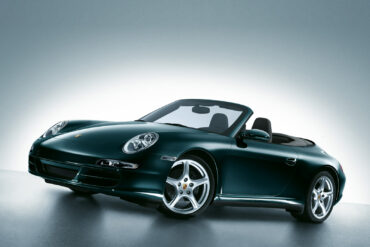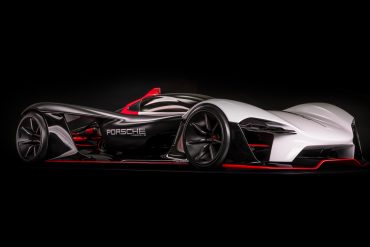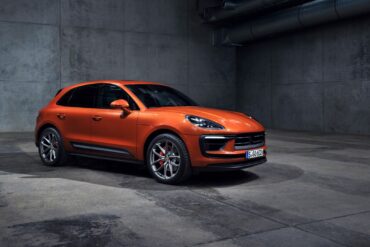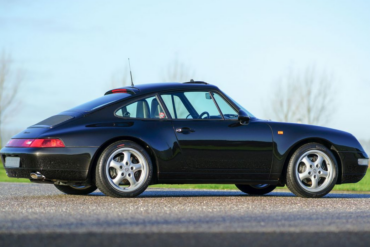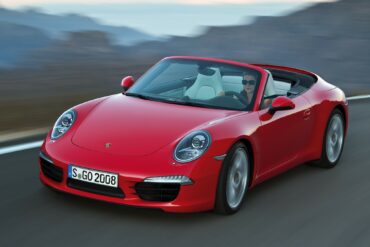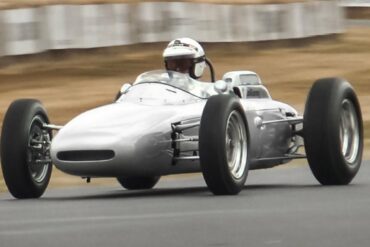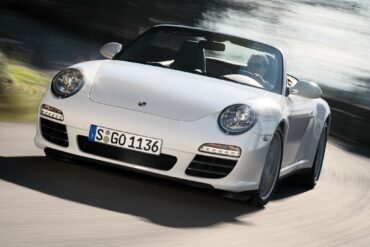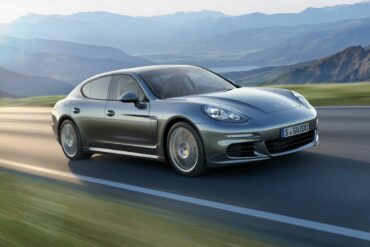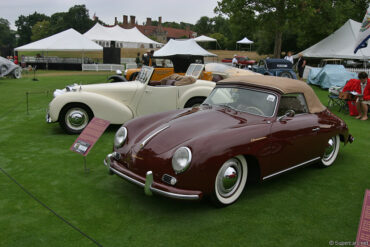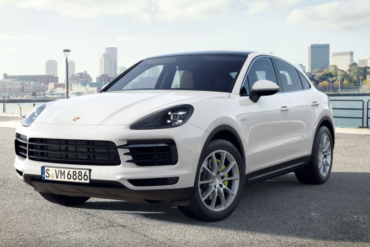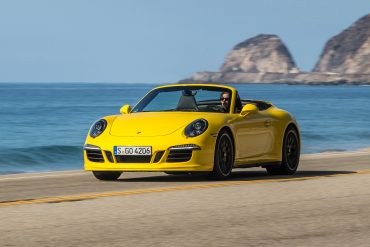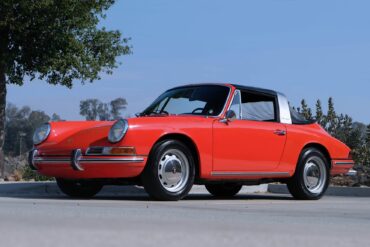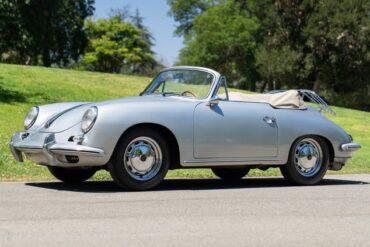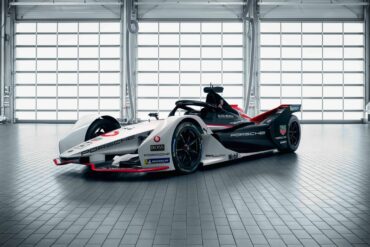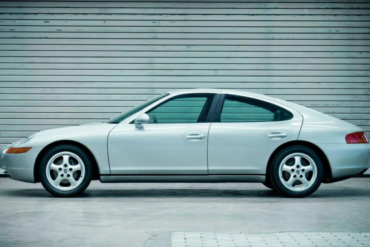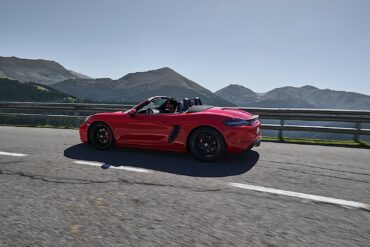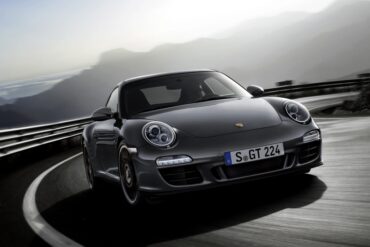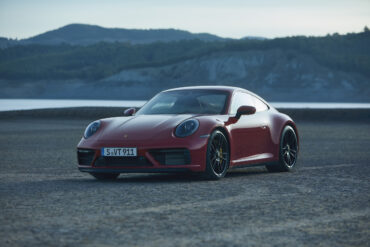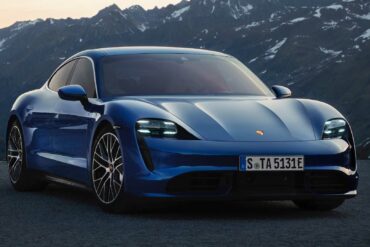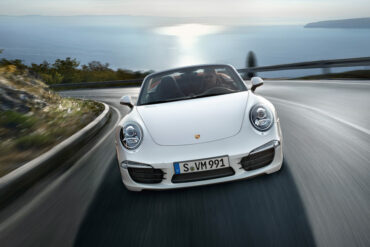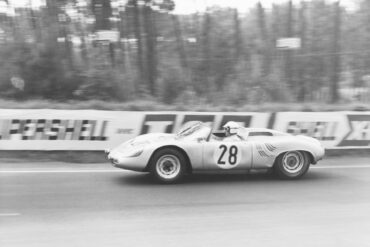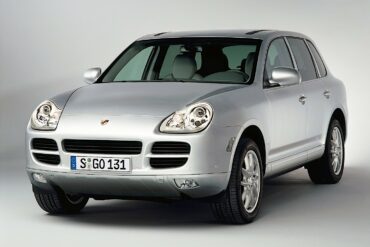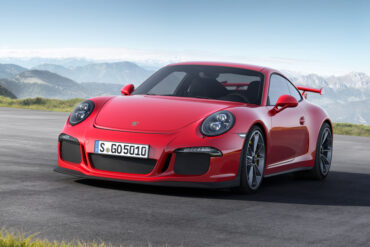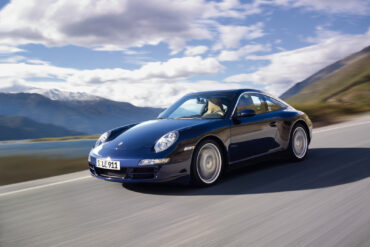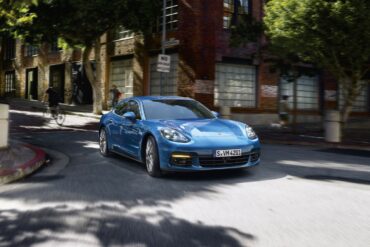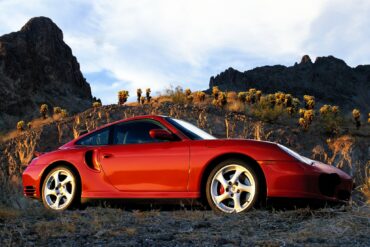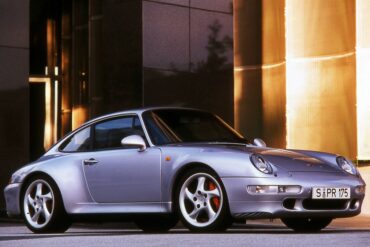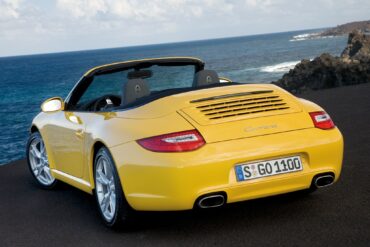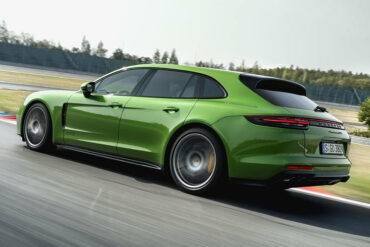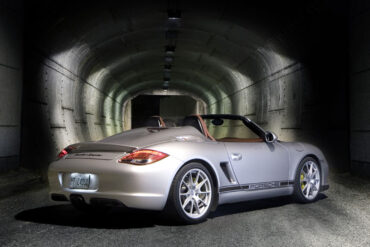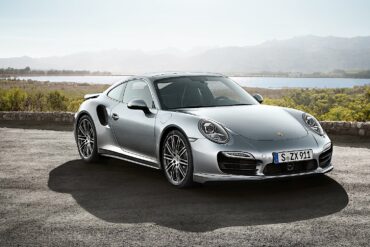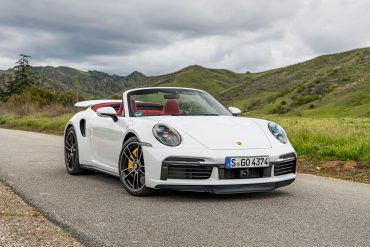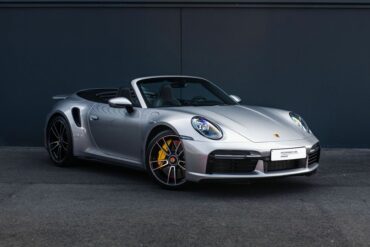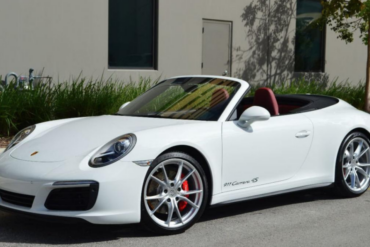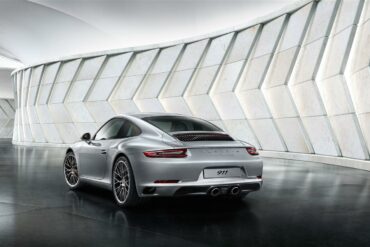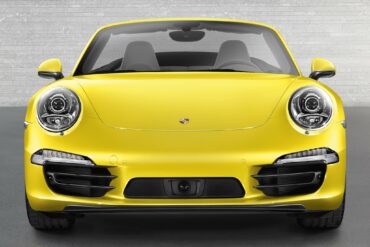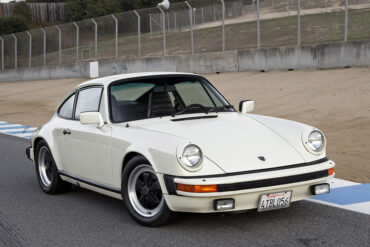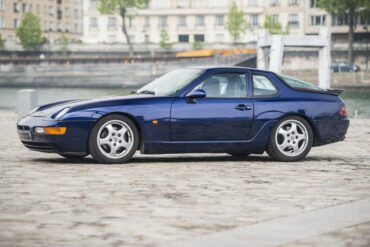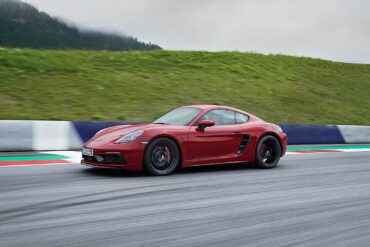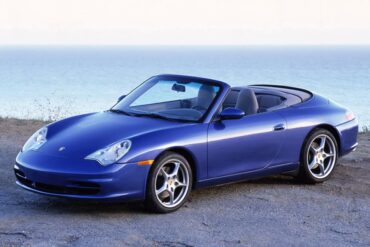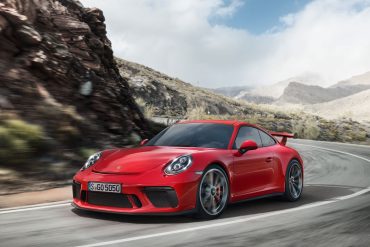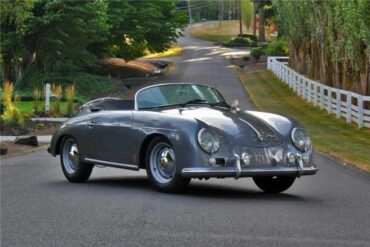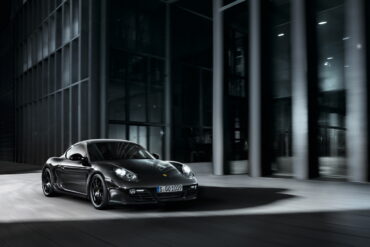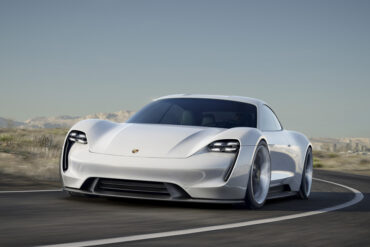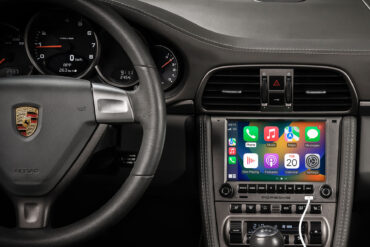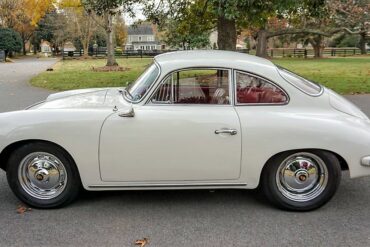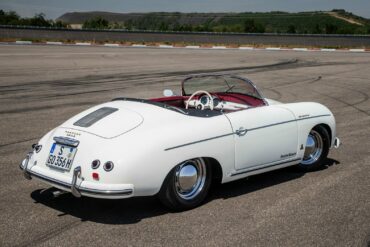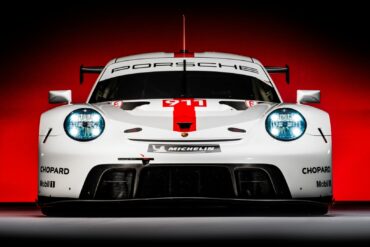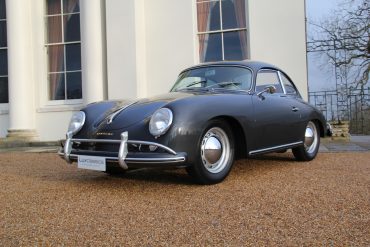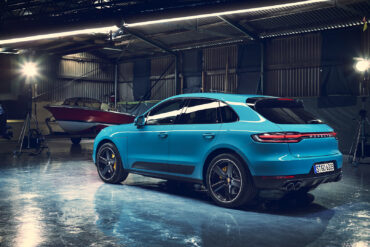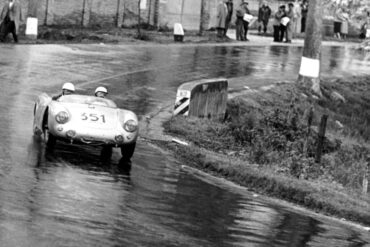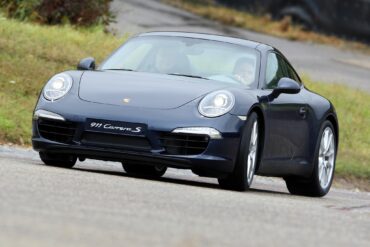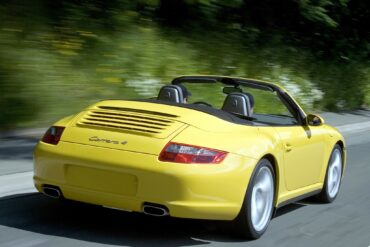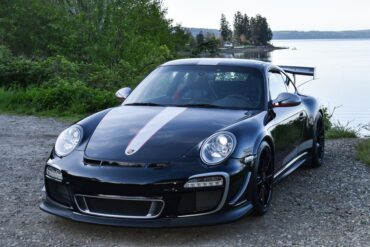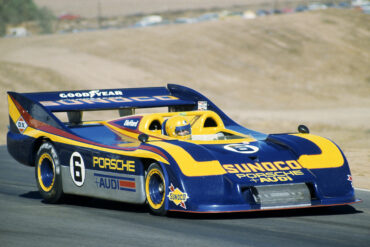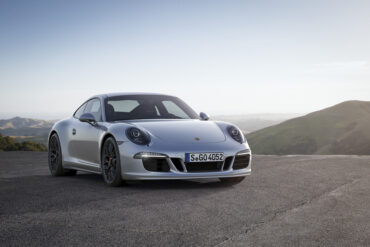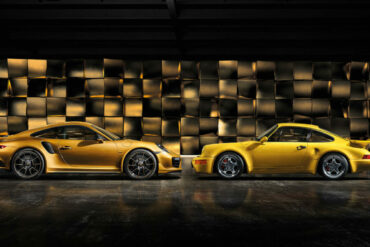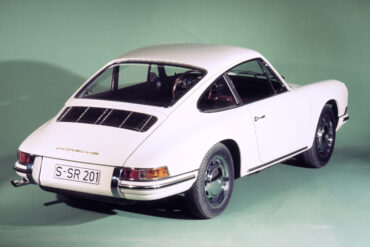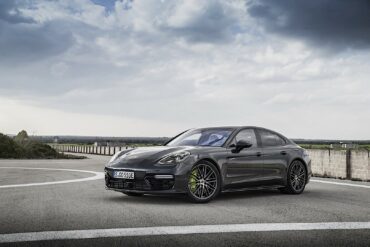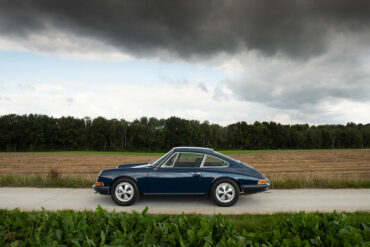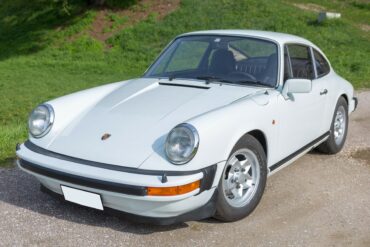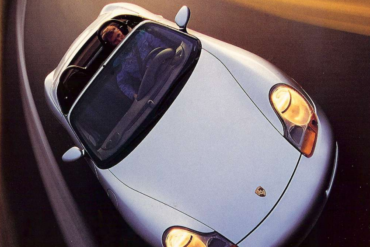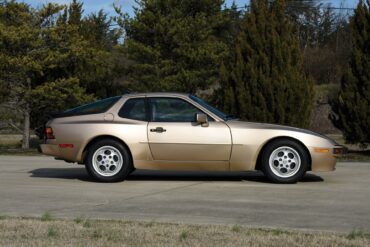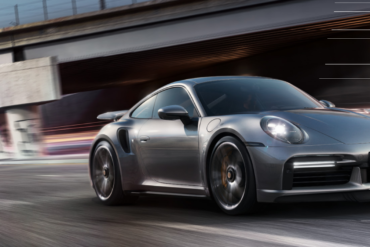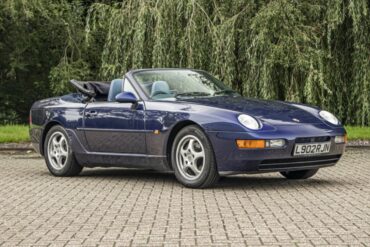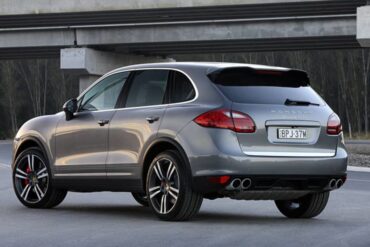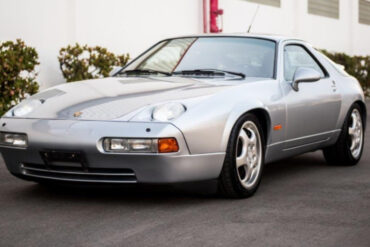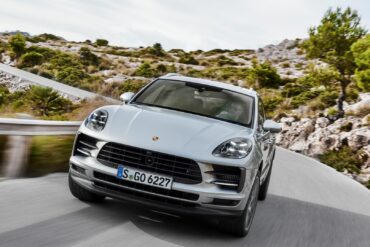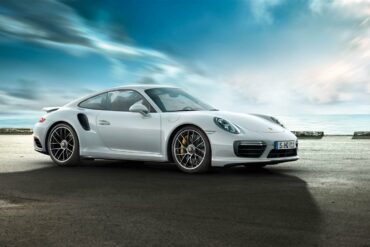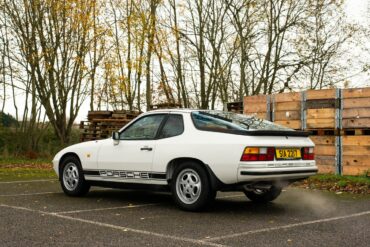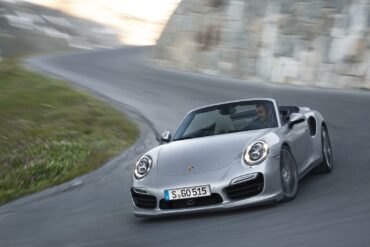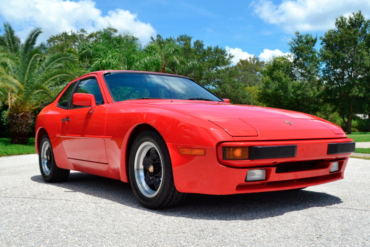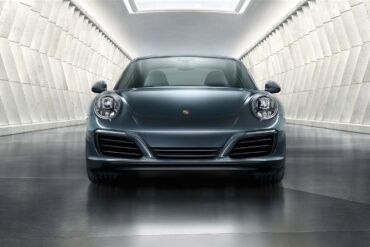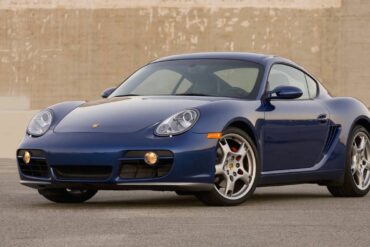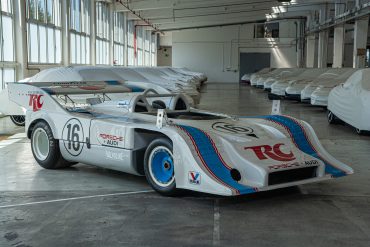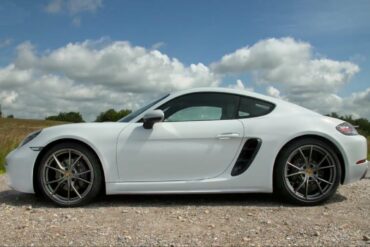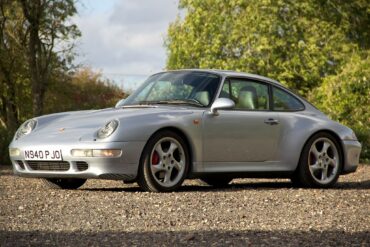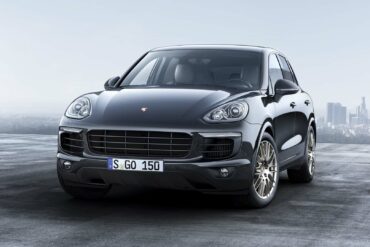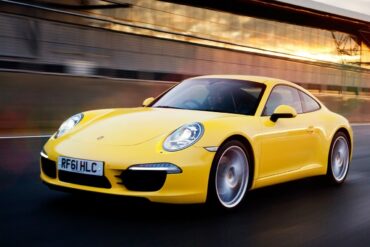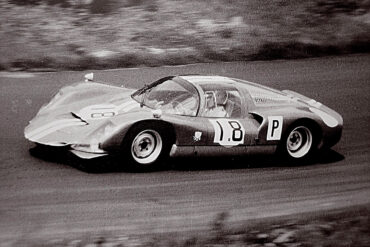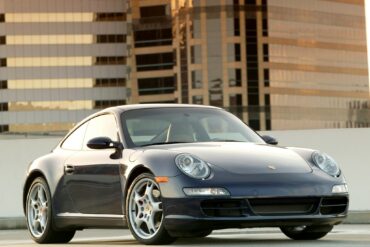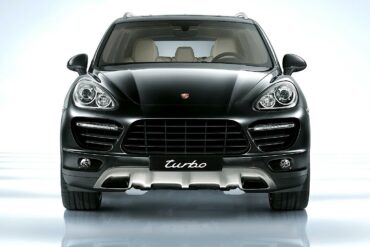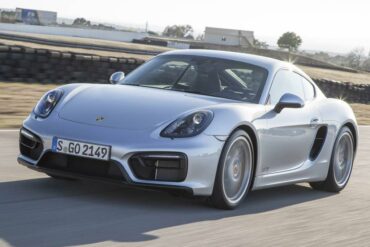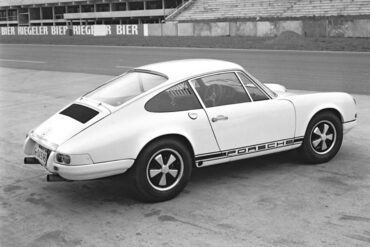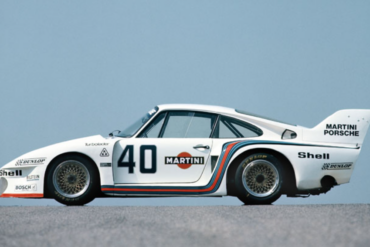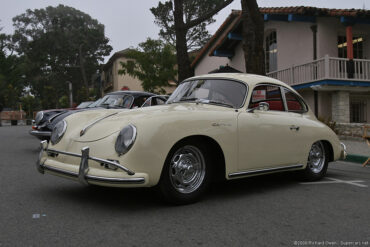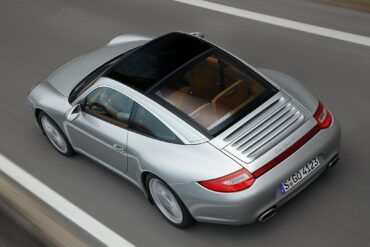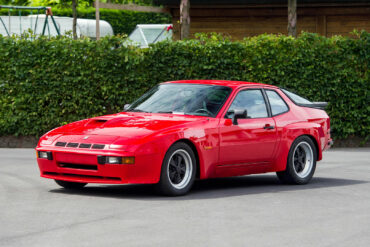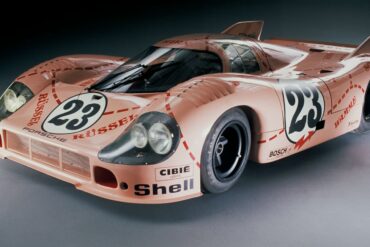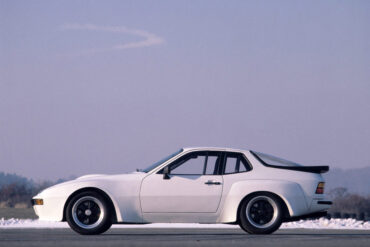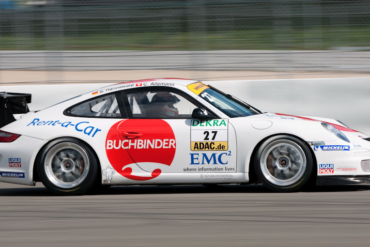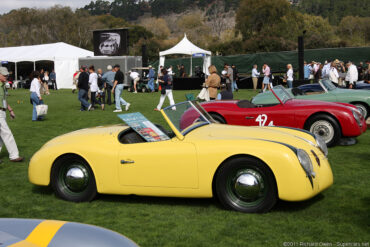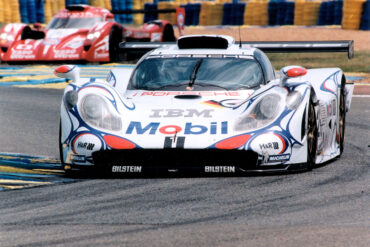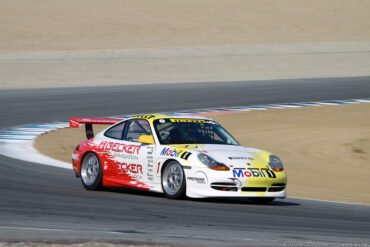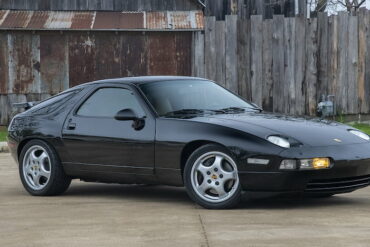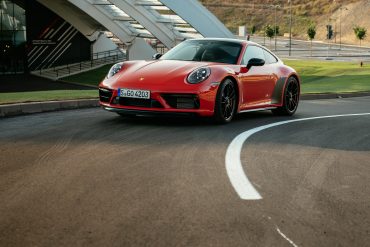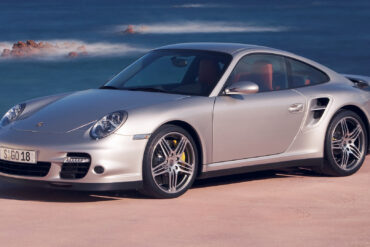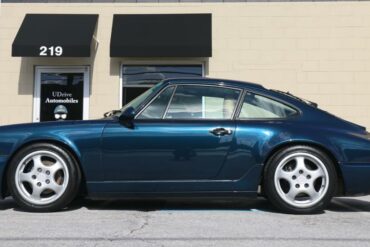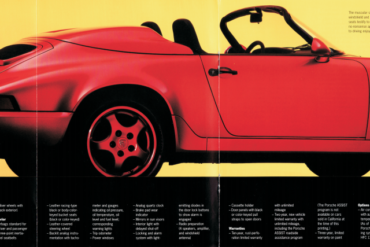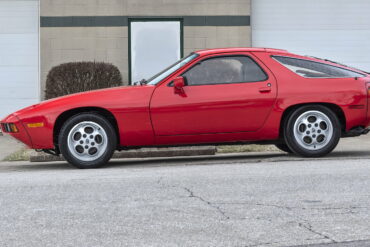2007 Porsche 911 Carrera 4 Cabriolet (997) Technical Specifications Engine Type Flat 6 Induction Normally-aspirated Cooling Water-cooled Valvetrain Double overhead...
The Porsche Vision E is a race car concept, designed and built by Porsche in 2019, to preview what essentially would be a future customer race car from Porsche. Using technology from their Formula E race car, the Porsche 99X, the company says that this concept would preview what would be a race car that private individuals can drive, to get the closest feel to Formula E in terms of performance and driving dynamics.
Front fascia with newly designed spoiler. The characteristic Macan side blades in new designs. The redesigned rear fascia and diffuser. Revised steering wheel options. The base turbocharged 2.0-liter four-cylinder now makes 261 horsepower. Standard features include a 10.9-inch touchscreen infotainment system, a 10-speaker audio system, and LED headlights.
1996 Porsche 911 Carrera (993) Technical Specifications Engine Type Flat 6 Induction Naturally Aspirated Cooling Air/oil-cooled Valvetrain Single overhead camshaft...
The open-top 991 Carrera S Cabriolet requires an $11,600 premium over a comparable coupe; ta not-cheap $108,950 price point for those shopping. For that, you get the best overall open-top sports car around. With the 400-hp, 3.8-liter six and the benefit of the PDK automatic’s launch control, the Carrera S cabriolet should hit 60 mph in 3.8 seconds and cover the quarter-mile in the low 12s. Performance is on-par with the coupe on backroads so any fears that this is a soft-911 are thrown out the window. This is a serious sports car, sans roof.
The Porsche 804 was produced by Porsche to compete in Formula One (F1). It raced for a single season in 1962 in the 1½ litre formula. For 1962 Porsche developed an 8-cylinder engine for F1. It was air-cooled and had twin overhead camshafts, four Webber carburetors, and two valves per cylinder. Porsche stayed with carburetors and steel rims while other manufacturers had moved to lightweight wheels and fuel-injection.
2009 Porsche 911 Carrera 4S Cabriolet (997.2) Technical Specifications Engine Type Flat 6 Induction Normally-aspirated Cooling Water-cooled Valvetrain Double overhead camshafts Injection...
The entry-level Panamera featured a 3.6-liter V6 engine carried-over from Audi. It was paired as standard to a 6-speed manual. A 7-speed PDK (dual-clutch) was on the options list. The base-model Panamera and Panamera 4 were introduced in 2010. While it came later than the initial variants, the base Panamera was no second class car. As a everyday passenger car it was plenty powerful with great luxury and plenty of standard features.
1955 Porsche 356/1500 Continental Cabriolet (Pre-A) Technical Specifications Type Series Production Car Built At Stuttgart, Germany Body Stylist Erwin Komenda...
Porsche fitted the Cayenne E-Hybrid with a turbocharged 340 hp 3.0-liter V6 engine combined with a 136 hp electric motor for the drivetrain. Total combined power output reached 462 hp. The whole assembly was mated to an 8-speed automatic transmission that sent the power in all corners. Now it comes with a coupe body? Not sure the combination makes much sense to us, but hey this is Porsche and they know more than we do I guess.
2016 Porsche 911 Carrera GTS Cabriolet (991) Technical Specifications Engine layout Rear Engine Engine type Boxer-6 Cylinders 6 Valves per...
1968 – 1969 Porsche 911 T Targa 2.0 (SWB & LWB) Technical Specifications Engine Type Flat 6 Induction Normally-aspirated Cooling...
1964 Porsche 356C/2000GS Carrera 2 Cabriolet Technical Specifications Model Years 1964 Built At Stuttgart, Germany Engine 2.0 L Aircooled Flat...
Spark Racing Technology is responsible for a big part of the Porsche 99X Electric. This is the racing car Porsche fielded in Formula E 2019 season. Maximum performance in qualifying mode? 335 horsepower and 174 mph. Zero to 100 kilometers per hour is doable in 2.8 seconds, and the minimum weight including the driver is rated at 900 kilograms of which the battery is responsible for 385 kilograms. In race and attack modes, the output is restricted to 272 and 320 PS, respectively. The useable battery capacity is 52 kWh while maximum recuperation is rated at 250 kW.
The Porsche 989 a four door performance oriented touring sedan that maintained the iconic shape of the 911 Carrera, but unlike the Panamera, never saw production after it was developed by Porsche between 1988 and 1991. After Ulrich Bez left Porsche in September 1991, the project lost momentum. The severe slump in 928 sales made executives re-think the project. The Porsche Panamera is considered to be the spiritual successor to the 989 project.
2018 Porsche 718 Boxster GTS (982) Technical Specifications Engine Type Flat 4 Induction Turbocharged Cooling Water-cooled Valvetrain Double overhead camshafts...
The new Porsche 911 Carrera 4 GTS combines a 408 hp 3.8-litre flat six engine with intelligent all-wheel drive that delivers a further exhilarating dimension to the dynamics of the iconic rear-engined sports car. The 911 was first offered with four-wheel drive in 1989 and the drivetrain has been a popular option ever since. Now, the 911 Carrera 4 GTS broadens customer choice in 2011, building on the success of the two-wheel drive Carrera GTS that went on sale in December last year. The 911 Carrera 4 GTS power unit has its origins in the 3.8-litre, six-cylinder from the Carrera S, with the power kit added.
The reality was that in the past you could basically build your own GTS. In the past, Porsche offered an optional factory "power kit" for 911 Carreras, but things are different now. That isn't an option for the 992. The 992 Porsche 911 Carrera GTS is therefore your only pass for accessing a version of the 3.0-liter twin-turbo flat-six tuned up to 473 hp and 420 ft lbs of torque. Those figures are achieved via an approximately 14.5 percent increase in turbo boost pressure.
Porsche Option Codes – 2020 Taycan Looking to decode your 2020 Porsche Taycan option codes? Want to know what those...
2013 Porsche 911 Carrera S Cabriolet (991) Technical Specifications Engine Type Flat 6 Induction Normally-aspirated Cooling Water-cooled Valvetrain Four overhead camshafts,...
Porsche 718 W-RS Spyder Specifications type Racing Car built at Germany predecessor 1961 Porsche 718 RS61 Spyder engine Boxer-8 valvetrain...
Porsche Cayenne Spare Parts Catalogs (2003 – 2006 Model Year) These official Porsche PET Diagrams and codes for the current...
Porsche introduced the 991 GT3 for the 2014 model year, as follow up to the multiple 997 GT3 variants. The 991 GT3 featured a new 3.8 litre direct fuel injection (DFI) flat-six engine developing 475 hp (354 kW; 482 PS) at 8,250 rpm, Porsche's Doppelkupplung (PDK) double-clutch gearbox, and rear-wheel steering. The 911 GT3 is claimed to be able to accelerate from 0-60 mph (97 km/h) in 3.1 seconds or less, and the quarter mile in 11.2 seconds at 126 mph (203 km/h). It evolved into the 991.2 GT3 for model year 2018.
The two 997 Targa 4 cars are both offered in only all-wheel-drive. Available with either a 3.6 litre flat 6 in the Targa 4, or with a more powerful 3.8 litre flat 6 in the Targa 4S, the new car offers almost all the fun of a convertible without sacrificing the dynamic abilities of a hardtop. The Targa 4S gets to 60 mph in 4.7 seconds and tops out at 179 mph thanks to its 3.8 liter flat six pumping out 350 bhp and 295 ft lbs of torque. It has softer spring rates than the coupe, a more generous helping of leather in the cabin, a better tally of standard equipment, more storage space behind the front seats.
The Panamera finally looked great, with a wider, lower, sleeker design that fixed all the hunchback look of the old design. Porsche launched the second generation Panamera for the 2017 model year. Complementing the fresh threads is a completely reimagined interior, replete with touch-capacitive surfaces and massive display screens. The Panamera 4 got a 3.0-liter, turbocharged V-6 with 325 bhp @ 5400 rpm and 332 ft lbs @ 1800 rpm. Performance was impressive, taking only 5.6 seconds to hit 60 mph and a respectable 163 mph top speed.
2004 Porsche 911 Turbo (996) Technical Specifications Engine Type Flat 6 Induction Twin-turbocharged Cooling Water-cooled Valvetrain Double overhead camshafts Injection...
1996 Porsche 911 Carrera 4S (993) Technical Specifications Engine Type Flat 6 Induction Naturally Aspirated Cooling Air/oil-cooled Valvetrain Single overhead...
2009 Porsche 911 Carrera Cabriolet (997.2) Technical Specifications Engine Type Flat 6 Induction Normally-aspirated Cooling Water-cooled Valvetrain Double overhead camshafts Injection...
For the 2019 model year, the second-gen Panamera is now a beneficiary of the badge - which actually stands for ‘Gran Turismo Sport’ - that has come to represent the pragmatist’s choice of Porsche automobile. The Panamera GTS is also now available in a long-roof wagon body style, dubbed the Sport Turismo. In totality, this is the vehicle I will be writing about - the 2019 Porsche Panamera GTS Sport Turismo. Traditionally speaking, the GTS version of any Porsche has typified a “sport-plus” version of a mid-level trim within the model range.
(2011 – 2012) Porsche Boxster Spyder (987.2) Technical Specifications Top speed figures of the Spyder are measured without soft top...
The 2014 Porsche 911 Turbo is a technological extravaganza. Adaptive aerodynamics, four-wheel steering, torque vectoring, active four-wheel drive, adaptive dampers, launch control, twin-clutch automatic gearbox – you get the picture. This is the first time we've had a chance to sample all of this on British roads. Two versions are available; both are powered by an uprated version of the previous 911 Turbo's 3.8-litre twin-turbo flat-six engine. The new 911 Turbo has even more power and more electronic systems. It is still a straight-line monster that will blow you away in terms of the sheer might of that engine and traction.
2023 Porsche 911 Turbo Cabriolet (992) Technical Specifications Model 911 Turbo Cabriolet Engine layout Rear Engine Design and cylinders Twin-turbocharged...
2023 Porsche 911 Turbo S Cabriolet (992) Technical Specifications Model 911 Turbo S Cabriolet Engine layout Rear Engine Design and cylinders...
2019 Porsche 911 Carrera 4S Cabriolet (991.2) Technical Specifications Engine layout Rear Engine Engine type Boxer, twin-turbo Cylinders 6 Valves per...
2018 Porsche 911 Carrera S Coupe (991.2) Technical Specifications Engine Engine layout Rear Engine Engine type Boxer, twin-turbo Cylinders 6 Valves...
2014 Porsche 911 Carrera 4S Cabriolet (991) Technical Specifications Engine Type Flat 6 Induction Normally-aspirated Cooling Water-cooled Valvetrain Four overhead camshafts,...
Porsche Option Codes – Porsche 911 (1978 Model Year) Looking to decode your 1978 Porsche 911 option codes? Want to...
Porsche Option Codes – Porsche 968 (1994 Model Year) Looking to decode your 1994 Porsche 968 option codes? Want to...
Porsche expanded its mid-engine range with the new two-seater Porsche 718 Boxster GTS and Porsche 718 Cayman GTS. The vehicles' power has now been increased to 269 kw (365 hp) thanks to a newly developed intake duct and an optimised turbocharger for the 2.5-litre, four-cylinder boxer engine. With these improvements, the engine delivers 11 kW (15 hp) more power than the 718 S model and up to 26 kW (35 hp) more power than its GTS predecessor models with naturally aspirated engines. The new mid-engine sports cars are available with manual six-speed transmission or optional PDK
The 996 was initially available in a coupé or a cabriolet (Convertible) bodystyle with rear-wheel drive, and later with four-wheel drive, utilising a 3.4 litre flat-6 engine generating a maximum power output of 221 kW (300 PS; 296 hp).[7] The 996 had the same front end as the entry-level Boxster. After requests from the Carrera owners about their premium cars looking like a "lower priced car that looked just like theirs did", Porsche redesigned the headlamps of the Carrera in 2002. With the cabriolet, buyers have a choice between this version and the hotter Carrera 4S cabriolet.
Porsche Option Codes – Porsche 911 (2018 Model Year) Looking to decode your 2018 Porsche 911 option codes? Want to...
1956 – 1957 Porsche 356A/1300 Super Speedster Technical Specifications WHAT BODY STYLE? 2 door fixed-head coupé with 2+2 seats HOW...
2012 Porsche Cayman S Black Edition Technical Specifications type Series Production Car released at 2010 LA Auto Show built at...
With the Mission E prototype at the IAA 2015, Porsche offered a preview of a vehicle that will be a genuine Porsche and a fully-fledged alternative to vehicles with a combustion engine – in terms of both driving performance and range. The concept car combines the unmistakable emotional design of a Porsche with excellent performance and the forward-thinking practicality of the first 800-volt drive system. Four doors and four single seats, all electric and over 600 hp.
Porsche Classic offers new infotainment systems: Since 2020, Porsche Classic has offered two infotainment systems for many of the brand’s...
Porsche 356 Spare Parts Catalogs (1960 – 1965 Model Year) Porsche 356B/356C These official Porsche PET Diagrams and codes for...
1954 – 1955 Porsche 356/1500 Speedster Technical Specifications Type Series Production Car Built At Stuttgart, Germany Body Stylist Erwin Komenda...
(2019-2021) Porsche 911 RSR (991.2) Technical Specifications Technical data Porsche 911 RSR model year 2019 Engine Water-cooled six cylinder boxer...
From the outside, the 356A kept to the Porsche mantra of stepwise evolution. The new model was outwardly identical to the previous version except for the wider tires, a small rub-strip below the doors, a fully-curved front window and enamel paint replacing lacquer previously used. The 356 A came with an all-alloy air-cooled Flat 4 engine in four states of tune, with the 1300 having Type 589/2 engine with 60 bhp and 65 lb-ft of torque.
Porsche Option Codes – 2019 Macan Looking to decode your 2019 Porsche Macan option codes? Want to know what those...
Porsche 550 RS Spyder Specifications Starting with Chassis 550-03 (the third Porsche 550 prototype), Porsche gave the 550 the latest...
2015 Porsche 911 Carrera S Coupe (991) Technical Specifications Engine Type Flat 6 Induction Normally-aspirated Cooling Water-cooled Valvetrain Four overhead camshafts,...
2006 Porsche 911 Carrera 4 Cabriolet (997) Technical Specifications Engine Type Flat 6 Induction Normally-aspirated Cooling Water-cooled Valvetrain Double overhead...
2009 – 2012 Porsche 911 GT3 & GT3 RS (997.2) Service Schedule (3.8 L & 4.0 L) This maintenance service...
Porsche 917/30 Specifications type Racing Car built at Germany production 6 units engine Air Cooled, Magnesium/Aluminum Alloy Flat-12 position Mid...
More aggressive looks, significant extra power, and highly desirable options. This is the perfect all-round 911. In manual, there is nothing that feels as complete. Some of the technical ingredients that generate even more driving dynamics and driving fun: 430 hp (316 kW) power, the Sport Chrono package and the PASM active damper system which lowers the car's ride height by ten millimetres. The extra punch of the 430-hp engine pushes the 911 Carrera GTS coupe up to 190 mph in rear-wheel-drive/manual-transmission configuration, 2 mph higher than the 400-hp Carrera S.
2019 Porsche 911 Turbo S Exclusive (991.2) Technical Specifications Engine Engine layout Rear Engine Engine type Boxer, twin-turbo Cylinders 6 Valves...
In 1963 Porsche introduced their seminal 901 at the 911 at the Frankfurt Motor Show which would be renamed 911 for the 1964 model year. The new car was sold alongside the 356C as an alternative with more power and room for a rear seat. At the 1963 Frankfurt show the public saw Porsches new direction. Compared to the 356 it had a longer wheelbase, a more compact suspension setup and much more power from the flat-6 engine.
By combining a Porsche Panamera Turbo with the hybrid system already developed for the 4 E-Hybrid, the result is pretty epic. The new Porsche Panamera Turbo S E-Hybrid sees the sportscar manufacturer launch a plug-in hybrid model as the flagship of a model line for the first time. The four-litre V8 engine from the Panamera Turbo is combined with an electric motor, resulting in 500 kW/680 hp of system power and outstanding power delivery: Even when just above idle speed, the Panamera Turbo S E-Hybrid offers an 850 Nm of torque. How about 3.4 seconds 0 - 60 mph time???
1967 – 1968 Porsche 911 S Coupe 2.0 (SWB) Technical Specifications Engine Type Flat 6 Induction Normally-aspirated Cooling Air/oil-cooled Valvetrain...
Production of the second generation 911 started in August 1973. The 1974 model year G-series derivative replaced the outgoing 1973 model year F-series. Visually, the new 911 was given a major facelift and all three production variants now came with fuel-injected 2.7-litre engines. The entry level 911 had 150bhp, the mid-range 911 S offered 175bhp and the flagship 911 Carrera came with 210bhp. Once again, customers were given the choice of either Coupe or Targa body styles.
Porsche Boxster (First Generation) Sales Brochures We found only two Porsche sales brochures for the first generation Boxster, which is...
Porsche 944 Paint Color Options & Samples This post outlines all the color options for the Porsche 944 over its...
Porsche 911 Sales Brochures (Type 992) We found quite a few Porsche sales brochures for the Type 992 911 generation....
Launched in August 1991 for the 1992 model year, the 968 was available in two body styles: a Coupe and a Cabriolet. Cabriolets came with reinforced bodyshells to compensate for the lack of a roof. Porsche quoted a weight of 1370kg for the Coupe and 1440kg for the Cabriolet. Cabriolet top speeds were slightly slower owing to their messier aerodynamics, but it was dynamically pretty impressive despite the non-coupe body.
Porsche Option Codes – Porsche Cayenne (2010 Model Year) Looking to decode your 2010 Porsche Cayenne option codes? Want to...
Porsche 928 Production & Sales Units By going through VIN numbers we were able to figure out the production numbers...
The Macan has important upgrades for the 2019 model, featuring new and improved front lights with LED headlights as standard and three-dimensional LED lights in the rear. The new model features a 3.0-liter turbocharged V6 engine generating 348 horsepower and 354 lb-ft of torque. The new and more powerful engine marks an increase in both horsepower and torque over the prior Macan S models. 0 to 60 mph in 4.9 seconds with the optional Sport Chrono and top speed is 157 mph.
2017 Porsche 911 Turbo S (991.2) Technical Specifications Engine Engine layout Rear Engine Engine type Boxer, twin-turbo Cylinders 6 Valves per...
Porsche 924 Spare Parts Catalogs (1980 – 1985 Model Year) These official Porsche PET Diagrams and codes for the Porsche...
The 2014 Porsche 911 Turbo Cabriolet is a great companion to its coupe sibling. The Porsche 911 Turbo Cabriolet delivers the same blend of dynamism, performance and efficiency offered by the Coupe. The turbocharged 3.8-litre six-cylinder engine delivers 520 bhp and it helps drivers accelerate from zero to 60 mph in just 3.1 seconds (there goes your hair style). Compared to the 997.2 Turbo Cabriolet the new Turbo Cab delivers 30 bhp more power and are 0.2 seconds faster in terms of their standard acceleration. It is also up to 15% more efficient and more luxurious and comfortable to boot.
Porsche Option Codes – Porsche 944 (1983 Model Year) Looking to decode your 1983 Porsche 944 option codes? Want to...
2018 Porsche 911 Carrera Coupe (991.2) Technical Specifications Engine Engine layout Rear Engine Engine type Boxer, twin-turbo Cylinders 6 Valves per...
Porsche Option Codes – 2007 Cayman Looking to decode your 2007 Porsche Cayman option codes? Want to know what those...
Images by: Virtual Motorpix/Glen Smale and Corporate Archives Porsche AG The Porsche 917 was the culmination of a line of...
2017 Porsche 718 Cayman S (982) Technical Specifications Engine Type Flat 4 Induction Turbocharged Cooling Water-cooled Valvetrain Double overhead camshafts...
1997 Porsche 911 Carrera 4S (993) Technical Specifications Engine Type Flat 6 Induction Naturally Aspirated Cooling Air/oil-cooled Valvetrain Single overhead...
Porsche Option Codes – Porsche Cayenne (2018 Model Year) Looking to decode your 2018 Porsche Cayenne option codes? Want to...
2013 Porsche 911 Carrera S Coupe (991) Technical Specifications Engine Type Flat 6 Induction Normally-aspirated Cooling Water-cooled Valvetrain Four overhead camshafts,...
Porsche 906/8 Specifications Four factory 906s received an air-cooled eight-cylinder boxer engine of the type 771, which was already used...
2007 Porsche 911 Carrera S Coupe (997) Technical Specifications Engine Type Flat 6 Induction Normally-aspirated Cooling Water-cooled Valvetrain Double overhead...
The second generation of the Porsche Cayenne was launched at the 2010 Geneva Motor Show. It was a big improvement over its predecessor and featured an evolved design. For the engine, the Cayenne Turbo featured a 4.8-liter V8 unit which offered 500 hp. For the transmission, the 2010 Cayenne lost the low-range transfer case. The standard transmission was an 8-speed Tiptronic gearbox. All-wheel drive was installed standard as well. Other new improvements led to a decrease in the overall weight by 180 kg (400 lbs).
2014 Porsche Cayman GTS Technical Specifications Built At Stuttgart, Germany Engine Flat-6 Position Mid, Longitudinal Aspiration Natural Block Material Aluminum...
Based on the 911S, the 911 R was produced by Porsche to compete in the FIA’s GT 2.0 category. To make it competitive, the 911R was powered by a flat-six engine, Type 901/22 from the Porsche 906, capable of 210 hp. It went on a diet too, with weight savings coming from everywhere, getting the 911 R down to just 1,800 pounds dry. Four prototypes were constructed after which Porsche had coachbuilder Karl Baur build another 20 customer cars. In the end, because of the modifications to the 911R, the FIA refused to homologate the car.
The 935/77 was a result of relaxed rules and the car got a completely new suspension. The mirrors were incorporated into the front fenders and the rear window had a new angle. The 935/77 was visually very pleasing. While the 935/76 had a single turbocharger, the 2.85-litre engine of the 935/77 had two turbochargers. There was also a "baby" 935/77 built with a smaller 1.4-litre turbocharged engine to compete in the national German DRM series under 2 liter class.
1959 Porsche 356A/1600GS Carrera Technical Specifications Type Series Production Car Coachbuilder Reutter Karosserie Engineers Klaus von Rücker Engine Type 692/2...
2012 Porsche 911 Targa 4 (997.2) Technical Specifications Engine Type Flat 6 Induction Normally-aspirated Cooling Water-cooled Valvetrain Double overhead camshafts Injection...
Porsche Option Codes – Porsche 924 (1980 Model Year) Looking to decode your 1980 Porsche 924 option codes? Want to...
An attempt to blend the best aerodynamic characteristics from both the short-tailed 917 K and long-tailed 917 LH led to the the 917/20, otherwise known as the Pink Pig. The car's combination of a long body, stubby face, and wide hips gave it a pig-like look, which inspired Porsche designer Anatole Lapine to give the car a pink paint job with butcher cut lines covering the exterior. It was hugely popular at the 1971 Le Mans race, and was the fastest in qualifying and nearly came in fifth place, before a brake failure caused it to crash before the finish line.
1981 Porsche 924 Carrera GTS Technical Specifications body stylist Harm Lagaay, Norbert Singer production 59 engine Inline-4 aspiration KKK Turbocharger...
2008 Porsche 911 GT3 Cup S (997) Technical Specifications Type Racing Car Built at Weissach, Germany Engine Boxer-6 w/Dry Sump Lubrication Displacement...
This isn't technically a Speedster, but the Type 540 (Typ 540 K/9-1 to be very precise) - known more commonly as the America Roadster - started the idea. The American Roadster was the direct predecessor of the Speedster. U.S. importer Max Hoffman convinced Porsche it needed a lightweight convertible to compete. It only had an emergency folding roof and could keep up with larger sports cars of the era. But the production methods used to create the America Roadster’s aluminum body proved to be too expensive, and in 1952 Porsche built only 21 units before its discontinuation in 1953.
The 1998 GT1 car was a totally rethink and vast upgrade versus the prior year car. 1998 Le Mans 24-hour race In the 1998 jubilee year, the Porsche team celebrated its 16th overall victory in Le Mans with a double win for the 911 GT1 98. On 6th/7th June, the winning car was driven by Laurent Aiello, Allan McNish and Stéphane Ortelli. It was almost 50 years to the day on which the first Porsche sports car saw the light of day.
1999 – 2001 Porsche 911 GT3 Cup (996) Technical Specifications Type Racing Car Built at Germany Engine Flat-6 Displacement 3598...
1994 Porsche 928 GTS Technical Specifications Model Year & Variant 1994 928 GTS Model Year 1994 Model Variant 928 GTS...
2022 Porsche 911 Carrera 4 GTS (992) Technical Specifications Model 911 Carrera 4 GTS Design and cylinders Twin-turbo boxer 6 Number...
2005-2007 Porsche 911 (997.1) Carrera, Carrera S, Carrera 4, Carrera 4S, Turbo Service Schedule This maintenance service schedule checklist is...
Porsche Option Codes – Porsche 911 (1994 Model Year) Looking to decode your 1994 Porsche 911 option codes? Want to...
Porsche 911 Sales Brochures (Type 964) We didn’t do well in trying to score some Porsche sales brochures for the...
1979 Porsche 928 Technical Specifications The Porsche Model 928 was launched in 1977 and was powered by a water-cooled V-8...


